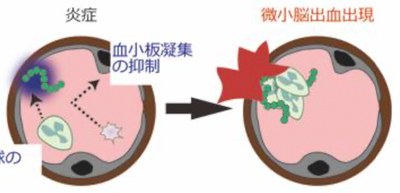
Mechanisms of stroke clarified from the relationship between a major pathogen of dental caries and the development of cerebral microbleeds
A group of researchers from the National Cerebral and Cardiovascular Center, Osaka University, Keio University, University of Southampton (UK), and University of Louisville (USA), has found that Streptococcus mutans (S. mutans), a major pathogen of dental caries expressing Cnm, a collagen-binding protein in the oral cavity, is related to the onset of cerebral microbleeds (CMB).
Stroke, the leading cause of prolonged bedrest (bedridden), is classified into main categories: ischemic strokes (caused by blockage of an artery or a vein) and hemorrhagic stroke (caused by bleeding), with the latter is further divided into two additional categories: intracerebral hemorrhage (ICH) and subarachnoid hemorrhage.
ICH accounts for about 20% of all strokes and happens at a young age, with the symptoms of hemorrhagic stroke tending to worsen quickly. ICH is associated with lifestyle-related diseases such as hypertension and diabetes, but there are other factors of ICH related to the risk.
In 2016, in Scientific Reports, an open-access Nature Publishing Group journal, this group reported a high prevalence of CMB in people with S.mutans. It is thought that one in every 5 individuals has cnm-positive S. mutans in the mouth, but chronological changes about whether CMB would increase in these people was not clarified.
This group took dental plaque from stroke patients who were admitted to the center with their consent and cultured S. mutans in plaque to examine the relationship between cnm-positive S. mutans and the development of CMB. They found that the incidence rate of CMB is 4.7 times higher in patients with cnm-positive S. mutans in their dental plaque than those without.
It is thought that cnm-positive S. mutans bind to collagen in the brain blood vessels weakened by lifestyle and aging cause inflammation, suppress platelets, which prevent and stop bleeding, and cause Cerebral hemorrhage.
This study clarified the relationship between cnm-positive S. mutans and cerebral hemorrhage, which will contribute to the clarification of mechanisms of strokes. Currently, basic research on mechanisms of how cnm-positive S. mutans causes cerebral hemorrhage, a prospective multi-center study with 15 domestic facilities, and a multinational observational study about the role of cnm-positive S. mutans are being conducted.
There are still more cerebral hemorrhage patients in Japan than in the United States and European countries. It’s effective to keep the mouth clean in order to reduce cnm-positive S. mutans in the mouth.
The article, “Oral Carriage of Streptococcus mutans Harboring the cnm Gene Relates to an Increased Incidence of Cerebral Microbleeds,” was published in Stroke at DOI: https://www.ahajournals.org/doi/10.1161/STROKEAHA.120.029607.
Related Links
Pediatric dentistry, Graduate School of Dentistry, Osaka University (link in Japanese)
